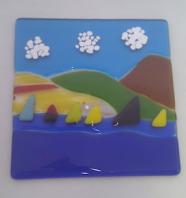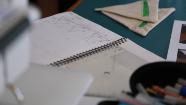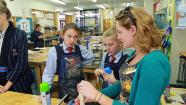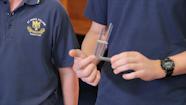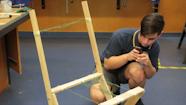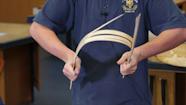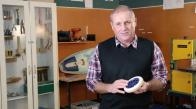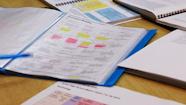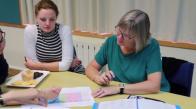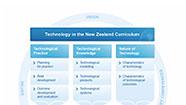Extending the range of materials: Fused glass
Teaching inquiry
How could I learn to use glass as a material within our technology programme?
Background | Fused-glass workshop | Curriculum links | Additional resources
Background
Sue Bristow at Gisborne Girls’ High was interested in extending the range of materials available in technology classes.
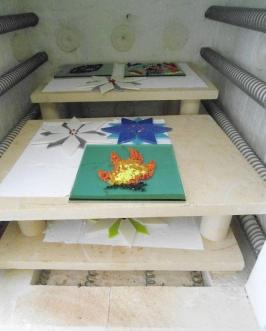
Kiln loaded with samples for firing
At the same time, Ray and Karryn Salisbury of Sauvarin Coloured Glass Studio Ltd were advertising fused-glass workshops and agreed to travel to Gisborne to run a workshop for teachers from several secondary schools.
What is glass fusing?
Glass fusing is the process of using a kiln to join together pieces of glass. If you apply heat to glass, it will soften. If you continue to apply heat, the glass will become more fluid and flow together. Two or more pieces of glass will stick (or "fuse") to each other. When the right kind of glass is heated and then cooled properly, the resulting fused glass piece will be solid and unbroken.
The glass is fired at different temperatures in a kiln. The different temperatures result in differing effects on the glass. These different firing temperatures can be applied to one piece of glass work in separate firings – allowing for many different outcomes.
For examples, see Images for fused glass.
Fused-glass workshop

Workshop participant's finished sea scene tile
The teachers left the fused-glass workshop with a multitude of ideas about how they could introduce this material into programmes. Sue and her teachers processed samples created on the day in the kiln and a larger tile sample was taken back to Auckland, fired by Ray and Karryn, and couriered back to the participants.
The workshop provided:
- knowledge of glass as a material
- the various forms it comes in
- how it can be manipulated in multiple ways using glass-fusing techniques
- information on sourcing materials and equipment.
The participants also came away with a network of other teachers to share ideas with in the future.
Select the headings below for more information about the content of the workshop.
Glass types and shapes
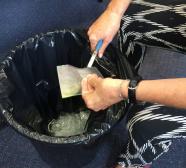
Cutting glass
The workshop covered the importance of using compatible glass to prevent cracking or devitrification (crystallization in a formerly crystal-free glass). The COE (coefficient of expansion) of glass must be the same.
Examples of what is happening to the glass at various stages of the firing schedules and of various types of schedules and how they impacted the glass were discussed.
The teachers learnt to successfully cut glass (float glass) and the range, use, and care of various cutting tools. They were given plenty of time to practise cutting techniques and the use of the various specialty glass tools during the day’s projects. Safety was emphasised at all stages, and strategies offered for how to manage safety with students.
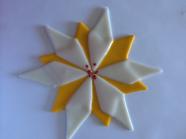
Star shape from cut glass
Topics covered were various methods of scoring glass, breaking out glass, and the correct use of glass tools such as grozing pliers.
The participants were also shown how to use an electric glass-cutting saw (Taurus glass saw) to cut more difficult shapes, such as a star for a poinsettia Christmas decoration.
The final challenge was to cut multiple pieces for a glass tile to create a sea scene. The design was provided so that participants could focus on practising their cutting skills. Although the designs were all the same, the finished tiles were personalised through different uses of colour.
Molds for fused glass
Fused glass can also be shaped as it is fired using various types of molds.
- For examples, see Images for molds for fused glass
Karryn outlined options for molds including stainless steel, ceramic, homemade, and terracotta pots.
- For examples, see Non-traditional molds for slumping
Other tools and materials used in molding are:
- kiln wash and hake brushes for priming slumped work
- glass carving – cutting out shapes using fibre papers and then placing these under the glass prior to firing.
Layering between glass
The teachers were shown many different materials that could be fused between layers of glass and on top of and beneath glass to create special effects. These included Tilly lantern mesh, baking soda, copper and silver foil, glass frit (compatible crushed coloured glass), and very fine glass rods.
It was clear that there are a many ways glass can be manipulated to create effects. Teachers took home 12 samples of these techniques.
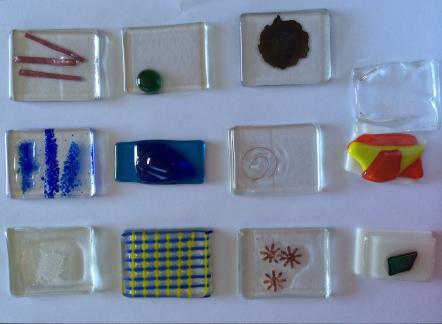
Participant's samples of layering and fusing glass
Hanging and firing fused glass
Karryn demonstrated various techniques that could be used to hang the glass so that the glass could be used for decorative purposes and also for jewellery. These included drilling holes, fusing a channel using a paper tube prior to firing, and using various jewellery findings for hanging.
The workshop provided information on firing schedules and maintaining the kiln to achieve the best outcome. Keeping a firing log is recommended so that desirable outcomes can be replicated.
Curriculum links
Technological products

Workshop participant's finished sea scene tile
Working with glass using fused-glass techniques can be a great way to develop students' understandings of the technological products component – for example, identifying materials and how these can be manipulated.
For more information about the technological products component, see: Technological products.
Technological modelling
There are also opportunities to teach about the technological modelling that is practised by technologists that work in this medium and to add some of these practices, such as drawing and sampling, into the students' own practice. Keeping a firing log is another form of technological modelling because previous outcomes and their firing techniques can be used as models for new work.
For more information about the technological modelling component, see Technological modelling.
Technological processing standards
The NCEA assessment resources include a level 2 processing standard written in the context of glass. For this resource, go to NCEA on TKI, Level 2 Technology assessment resources, and scroll to find Processing Technologies 2.60: Word document – 2.60 Glass v2.
Glass could be used as a medium to assess against both the level 1 and level 3 processing standards below:
- AS91082 Implement basic procedures to process a specified product
- AS91643 Implement complex procedures to process a specified product
Technological knowledge standards
The knowledge standards in processing could be used to assess understanding of glass processing at levels 1–3:
- AS91083 Demonstrate understanding of basic concepts used in processing
- AS91352 Demonstrate understanding of advanced concepts used in processing
At level 3 the knowledge standard has been incorporated within AS91643 Implement complex procedures to process a specified product.
Technological practice standards
At all three NCEA levels, technological outcomes in glass could also be assessed against the generic standards drawn from the technological practice strand.
Additional resources
A Day Made of Glass 2: Unpacked is an advertisement on You Tube showing how highly engineered glass, with companion technologies, could shape our future world. This could be used in discussions of the Nature of Technology strand and also in discussions around the use of glass as a material (making links to the technological products component).
The Chemistry of coloured glass is a useful downloadable poster showing science understandings linked to how glass is coloured.
Related videos
Will my design for an organiser work? (02:02)
Two year 8 students describe their functional modelling of their designs for organisers.
Will my design for a mirror work? (04:06)
Year 8 students talk about the functional modelling of their designs for mirrors and how they are fulfilling the brief....
Manipulating, forming, and transforming
Students in year 10 describe manipulating, forming, and transforming materials.
Evaluating materials for an outcome
Steve Andrew and students talk about using their knowledge to test materials for their projects at year 12.
Exploring unfamiliar materials (02:44)
Year 12 students from St John's College describe what they know about bamboo and how they are applying this knowledge to their projects....
Play, experiment, explore (02:55)
Steve Andrew lets the students see, feel, and play with products to develop their understandings in materials.
School-wide programme planning (04:18)
Cheryl Pym explains how collaboration forms the foundation for school-wide planning in technology education.
Reviewing programme planning in years 7–13 (03:23)
At Diocesan School planning focuses on technology components for years 7–10, and establishing scholarship potential in year 13....
Review of curriculum implementation (03:49)
Margaret van Meeuwen explains how a cycle of self-review has enhanced delivery of curriculum.

